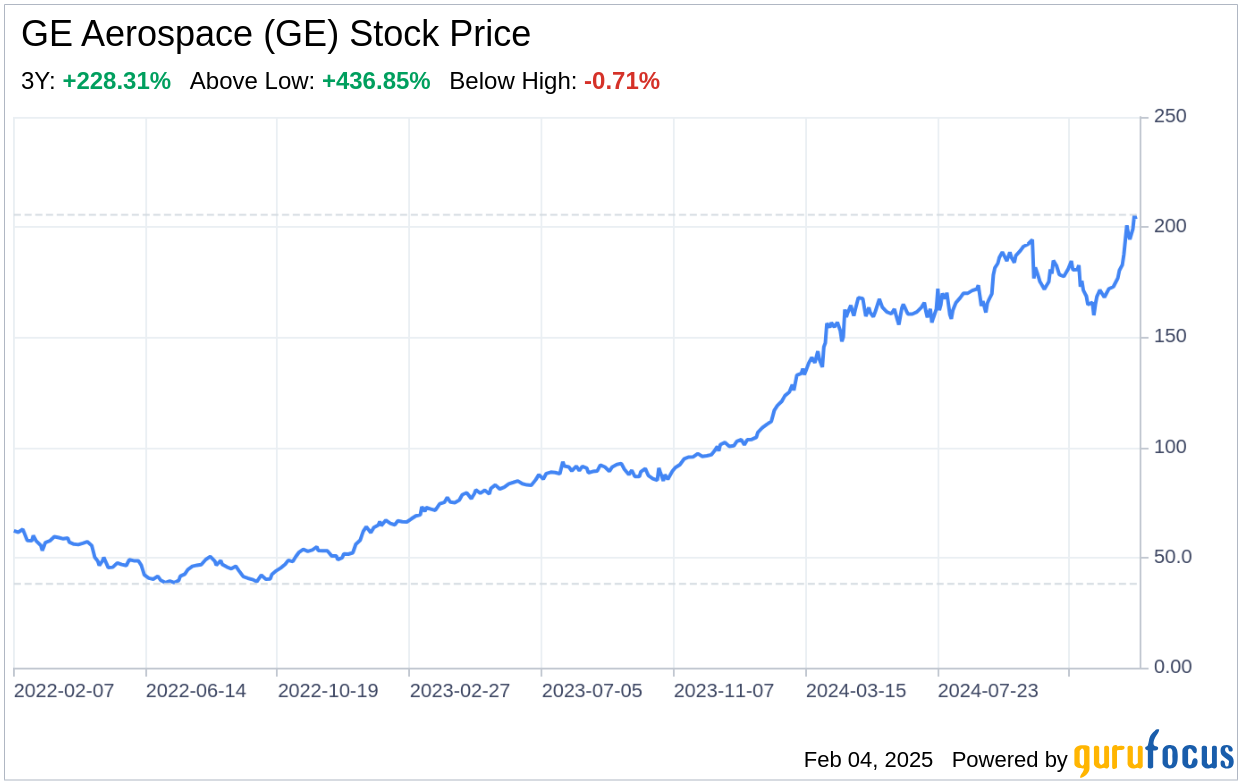On February 3, 2025, GE Aerospace (GE, Financial) filed its 10-K report, providing a comprehensive overview of its financial health and strategic positioning. As the global leader in aircraft engine design and servicing, GE Aerospace boasts a substantial installed base of 70,000 engines, driving a service revenue stream that constitutes the majority of its profits. The company's financial tables reveal a strong balance sheet, with service revenue reflecting resilience and customer demand. This SWOT analysis delves into the strengths, weaknesses, opportunities, and threats as disclosed in the 10-K filing, offering investors a nuanced understanding of GE Aerospace's market position and future prospects.

Strengths
Robust Service Revenue: GE Aerospace's service revenue, representing approximately 70% of total revenue, is a testament to its strong market position and the longevity of its products. This recurring revenue stream provides financial stability and predictability, which is crucial in the cyclical aerospace industry. The company's large installed base ensures a steady demand for maintenance, repair, and overhaul (MRO) services, which translates into consistent cash flows and a buffer against market volatility.
Technological Leadership and R&D Commitment: GE Aerospace's dedication to research and development (R&D) is a cornerstone of its competitive advantage. The company's investments in advanced technologies, such as ceramic matrix composites and additive manufacturing, have solidified its leadership in product safety, quality, and efficiency. The RISE program suite of technologies, aimed at a more sustainable future of flight, exemplifies GE Aerospace's forward-thinking approach and its potential to capture emerging market opportunities.
Lean Operating Model - FLIGHT DECK: The implementation of the FLIGHT DECK lean operating model underscores GE Aerospace's focus on operational excellence. By prioritizing safety, quality, delivery, and cost, the company has streamlined processes and enhanced execution. This operational discipline not only improves customer satisfaction but also drives financial performance, aligning strategy with tangible results.
Weaknesses
Supply Chain Vulnerabilities: GE Aerospace's complex global supply chain is a double-edged sword. While it allows for a diverse range of inputs, it also exposes the company to risks such as geopolitical changes, material shortages, and supplier instability. The recent supply-constrained environment has highlighted these vulnerabilities, which could impact the company's ability to meet delivery schedules and maintain cost controls.
Legacy Business Risks: Despite strategic divestitures, GE Aerospace retains legacy business operations that present ongoing risks. The run-off insurance operations and the mortgage portfolio in Poland (Bank BPH) are remnants of GE's broader financial services past, which could potentially cause funding or liquidity stress in the future. These legacy issues require careful management to prevent adverse impacts on GE Aerospace's financial health.
Workforce Management Challenges: With a significant portion of GE Aerospace's workforce represented by unions, the company faces potential challenges in labor relations. The upcoming negotiations with U.S. unions in 2025 could result in demands for higher wages and benefits, which may increase operational costs. Additionally, maintaining a skilled workforce in a competitive labor market is crucial for sustaining innovation and operational efficiency.
Opportunities
Market Expansion through Innovation: GE Aerospace's R&D initiatives, such as the RISE program, position the company to lead in the next generation of flight technology. These advancements offer opportunities to capture new markets, particularly in sustainable aviation, which is becoming increasingly important as the industry focuses on reducing its carbon footprint.
Strategic Partnerships and Government Contracts: The company's ability to leverage government funding for R&D, especially in defense technologies, presents significant growth opportunities. By cultivating strategic partnerships and securing government contracts, GE Aerospace can expand its defense segment and diversify its revenue sources.
Global Market Penetration: With operations in approximately 120 countries, GE Aerospace has the opportunity to further penetrate global markets. The company's extensive manufacturing and service network provides a platform for growth in emerging economies, where air travel is expected to rise, driving demand for new and serviced engines.
Threats
Competitive Pressures: The aerospace industry is fiercely competitive, with pricing, product quality, and innovation being key differentiators. GE Aerospace must continuously innovate and manage costs to maintain its market position against global competitors who may offer aggressive financial incentives and advanced technologies.
Regulatory and Environmental Challenges: GE Aerospace operates in a highly regulated environment, with stringent environmental laws impacting operations. Compliance costs and the need to invest in eco-friendly technologies could strain the company's resources. Additionally, climate change regulations related to emissions from air travel may increase operating costs for airlines, potentially affecting demand for GE Aerospace's engines.
Cybersecurity Risks: As a technology-driven company, GE Aerospace faces significant cybersecurity threats. Any breach could have material effects on the company's operations, reputation, and financial condition. While GE Aerospace has robust cybersecurity measures in place, the evolving nature of threats requires constant vigilance and investment in security infrastructure.
In conclusion, GE Aerospace (GE, Financial) presents a compelling case of financial resilience and strategic foresight, as evidenced by its robust service revenue and commitment to R&D. However, the company must navigate supply chain complexities, manage legacy
This article, generated by GuruFocus, is designed to provide general insights and is not tailored financial advice. Our commentary is rooted in historical data and analyst projections, utilizing an impartial methodology, and is not intended to serve as specific investment guidance. It does not formulate a recommendation to purchase or divest any stock and does not consider individual investment objectives or financial circumstances. Our objective is to deliver long-term, fundamental data-driven analysis. Be aware that our analysis might not incorporate the most recent, price-sensitive company announcements or qualitative information. GuruFocus holds no position in the stocks mentioned herein.
